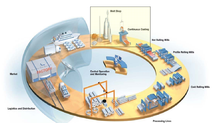Energy efficiency is one of the "trendiest topics” all over the world. A few days ago I read an article about new projects of the European Union regarding this matter. After the plan ‘Europe 2020’ was introduced in 2007 where a 20% reduction in energy consumption was proposed, today the ambitions goal of 27% of the energy production coming from renewable energy, achieving a 40% of CO2 reduction with an investment of 38000 million/year Euros is being discussed.
In my opinion, the biggest effort in order to reach that goals has to be done in industry. According to the International Energy Agency (‘Energy-Efficiency Policy Opportunities for Electrical Motor-Driven System’) the 40% of the total energy production is consumed by electrical motors.
Interaction between mechanical load and electrical drive is really strong. An improvement on the efficiency of each of them separately will improve the global efficiency of the system. It is does not mean that we have to act in mechanical load to improve the “mechanical load efficiency” and act in the electrical drive to improve the “electrical drive efficiency”, hence, the “global efficiency”. Thanks to "Power Electronic Drives", controlling the electrical motor adequately, we would able to keep the load working in regions of maximal efficiency. For instance, let's say that we have a electrical motor driving a compressor. Controlling the speed of the motor we can keep the operating point of the compressor away from the surge line.
Speaking about electrical motors, how can the energy be saved? For example, improving control techniques will provide a fast response in cases when something unexpected comes up. Electrical motor is a dummy machine; if the load gets bigger, motor requires more current to perform a movement, hence the energy consumption is rising. Avoiding that situation, we are already saving the energy.
Control system needs to have a close representation of the element that it is controlling, which is only possible by modelling, in particular mathematical modeling. As close as we can represent the actual state of the machine we will have more possibilities to improve the control technique.















